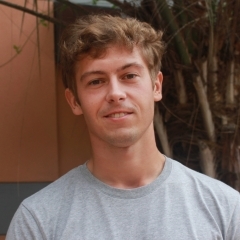
Date:
Location:
Speaker:
Title: Photonic & Epitaxial Design of Bio-inspired, Structured Surfaces for Optoelectronic Materials and Devices
Advisor: Mike Gordon
Abstract:
In recent decades, technological developments in optics, optoelectronics, and wetting phenomena have benefited from the principles underlying some of nature’s periodically structured and multifunctional surfaces. Particularly inspiring are the wavelength selectivity of vividly colored butterfly and bird wings, the light-coupling efficiency of the moth’s eye, and the self-cleaning properties of the lotus leaf. Bridging the technological gaps in structure, function, and design of engineered functional surfaces requires a simple, geometrically tunable, and high-resolution patterning method to probe the emergent phenomena that arise when materials are heterogeneously arranged at these critical nanoscale dimensions.
Accordingly, this talk will focus on the application of colloidal monolayer deposition coupled with plasma-based pattern transfer to realize novel hole-array and pillar structures in a variety of dielectric and semiconductor materials (GaN, TiO2, and Si). These were microscopically and spectroscopically investigated (SEM, photo-/cathodoluminescence, reflectometry, X-ray diffraction) to extract mechanistic understanding of optical and electronic behavior and corroborated with optical simulations (transfer-matrix and finite-difference time-domain methods). Applications that will be highlighted include the design of structurally colored TiO2 surfaces reminiscent of honeycombed centric diatom microalgae structures, mitigation of crystal defects and lattice mismatch in III-nitride LED materials, and dynamic, geometry-tunable wetting behavior afforded by hierarchical structuring of semiconductor (Si and GaN) surfaces.
Committee chair: Michael J. Gordon
Committee members: Steven P. DenBaars, Todd M. Squires, and Phillip Christopher



